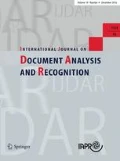Abstract
This paper presents a genetic programming based approach for optimizing the feature extraction step of a handwritten character recognizer. This recognizer uses a simple multilayer perceptron as a classifier and operates on a hierarchical feature space of orientation, curvature, and center of mass primitives. The nodes of the hierarchy represent rectangular sub-regions of their parent node, the tree root corresponding to the character's bounding box. Within each sub-region, a variable number of fuzzy features are extracted. Genetic programming is used to simultaneously learn the best hierarchy and the best combination of fuzzy features. Moreover, the fuzzy features are not predetermined, they are inferred from the evolution process which runs a two-objective selection operator. The first objective maximizes the recognition rate, and the second minimizes the feature space size. Results on Unipen data show that, using this approach, robust representations could be obtained that out-performed comparable human designed hierarchical fuzzy regional representations.
Similar content being viewed by others
References
Bäck, T., Fogel, D.B., Michalewicz, Z. (eds.): Evolutionary Computation 1: Basic Algorithms and Operators. Institute of Physics Publishing, Bristol, UK (2000)
Bäck, T., Hammel, U., Schwefel, H.P.: Evolutionary computation: comments on the history and current state. IEEE Trans Evol Comput 1(1), 3–17 (1997)
Banzhaf, W., Nordin, P., Keller, R.E., Francone, F.D.: Genetic Programming—An Introduction; On the Automatic Evolution of Computer Programs and its Applications. Morgan Kaufmann, Dpunkt.verlag (1998)
Coello, C.A.C., Veldhuizen, D.A.V., Lamont, G.B.: Evolutionary Algorithms for Solving Multi-Objective Problems. Kluwer, Berlin (2002)
Deb, K., Pratap, A., Agarwal, S., Meyarivan, T.: A Fast and Elitist Multiobjective Genetic Algorithm: NSGA-II. IEEE Trans Evol Comput 6(2), 182–197 (2002)
Dubreuil, M., Gagné, C., Parizeau, M.: Distributed BEAGLE: A distributed evolutionary computations extension of Open BEAGLE. Available at http://beagle.gel.ulaval.ca/distributed (2005)
Duda, R.O., Hart, P.E., Stork, D.G.: Pattern Classification, 2nd edn. Wiley, New York (2001)
Gagné, C., Parizeau, M.: Open BEAGLE: A new versatile C++ framework for evolutionary computation. In: Genetic and Evolutionary Computations COnference (GECCO) 2002, Late-Breaking Papers, pp. 161–168. New York (2002)
Gagné, C., Parizeau, M.: Open BEAGLE: An evolutionary computation framework in C++. Available at http://beagle.gel.ulaval.ca (2005)
Gagné, C., Parizeau, M., Dubreuil, M.: Distributed BEAGLE: Anenvironment for parallel and distributed evolutionary computations. In: Procceedings of the 17th Annual International Symposium on High Performance Computing Systems and Applications (HPCS) 2003, pp. 201–208. Sherbrooke (QC) (2003)
Guyon, I., Schomaker, L., Plamondon, R., Liberman, M., Janet, S.: Unipen project of on-line data exchange and recognizer benchmarks. In: Proceedings of the 14th International Conference on Pattern Recognition (ICPR), pp. 29–33 (1994)
Hagan, M.T., Demuth, H.B., Beale, M.H.: Neural Network Design. PWS Publishing, Boston, MA (1995)
Hébert, J.F., Parizeau, M., Ghazzali, N.: A new fuzzy geometric representation for on-line isolated character recognition. In: Proceedings of the 14th International Conference on Pattern Recognition, pp. 33–40 (1998)
Koza, J.R,.: Genetic Programming: On the Programming of Computers by Means of Natural Selection. MIT Press, Cambridge, MA (1992)
Koza, J.R,., David Andre, Bennett, F.H., III, Keane, M.: Genetic Programming 3: Darwinian Invention and Problem Solving. Morgan Kaufman, San Fransisco (1999)
Krawiec, K.: Genetic programming-based construction of features for machine learning and knowledge discovery tasks. Gene Prog Evol Mach 3(4), 329–343 (2002)
Li, X., Parizeau, M., Plamondon, R.: Segmentation and reconstruction of on-line handwritten scripts. Pattern Recogn 31(6), 675–684 (1998)
Parizeau, M., Lemieux, A., Gagne, C.: Character recognition experiments using unipen data. In: Proceedings of 6th International Conference on Document Analysis and Recognition (ICDAR), pp. 481–485 (2001)
Park, J., Govindaraju, V., Srihari, S.N.: OCR in hierarchical feature space. IEEE Trans Pattern Anal Mach Intell 22(4), 400–407 (2000)
Plamondon, R., Srihari, S.N.: Online and off-line handwriting recognition: a comprehensive survey. IEEE Trans Pattern Anal Mach Intell 22(1), 63–84 (2000)
Radtke, P.V.W., Wong, T., Sabourin, R.: A multi-objective memetic algorithm for intelligent feature extraction. In: Proceedings of the Third International Conference on Evolutionary Multi-Criterion Optimization (EMO 2005). Guanajuato, Mexico (2005)
Ratzlaff, E.H.: A scanning n-tuple classifier for online recognition of handwritten digits. In: Proceedings of 6th International Conf. on Document Analysis and Recognition (ICDAR), pp. 18–22 (2001)
Ratzlaff, E.H.: Methods, report and survey for the comparison of diverse isolated character recognition results on the unipen database. In: Proceedings of 7th International Conference on Document Analysis and Recognition (ICDAR), pp. 623–628 (2003)
Raymer, M.L., Punch, W.F., Goodman, E.D., Kuhn, L.A., Jain, A.K.: Dimensionality reduction using genetic algorithms. IEEE Trans Evol Comput 4(2), 164 (2000)
Sherrah, J., Bogner, R.E., Bouzerdoum, A.: Automatic selection of features for classification using genetic programming. In: Proceedings of the 4th Australian and New Zealand Intelligent Information Systems Conference (ANZIIS) (1996)
Sherrah, J., Bogner, R.E., Bouzerdoum, A.: The evolutionary pre-processor: Automatic feature extraction for supervised classification using genetic programming. In: Genetic Programming 1997: Proceedings of the Second Annual Conference, pp. 304–312. Morgan Kaufmann, Stanford University, CA (1997)
Teredesai, A., Govindaraju, V.: GP-based secondary classifiers. Pattern Recogn 38(4), 500–512 (2005)
Teredesai, A., Park, J., Govindaraju, V.: Active handwritten character recognition using genetic programming. In: Proceedings of EuroGP'Ol, LNCS, vol. 2038, pp. 371–379. Springer-Verlag, Berlin (2001)
Trier, O.D., Jain, A.K., Taxt, T.: Feature extraction methods for character recognition—a survey. Pattern Recogn 29(4), 641–662 (1996)
Yang, J., Honavar, V.: Feature subset selection using a genetic algorithm. IEEE Intell Syst 13, 44–49 (1998)
Author information
Authors and Affiliations
Corresponding author
Rights and permissions
About this article
Cite this article
Gagné, C., Parizeau, M. Genetic engineering of hierarchical fuzzy regional representations for handwritten character recognition. IJDAR 8, 223–231 (2006). https://doi.org/10.1007/s10032-005-0005-6
Received:
Revised:
Accepted:
Published:
Issue Date:
DOI: https://doi.org/10.1007/s10032-005-0005-6




